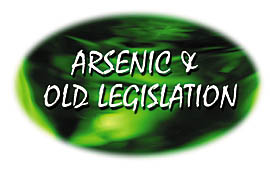
The U.S. Public Health Service first established a national standard for arsenic in drinking water in 1942. It was set at 50 parts per billion and remained unchallenged until 1975 with the inception of the Safe Drinking Water Act.
Most recently, in the waning days of the Clinton administration, the Environmental Protection Agency posted a rule that lowered the more than half-century-old standard to 10 ppb. Not long after, though, on March 22, 2001, under the new leadership of the Bush administration, the EPA withdrew the rule, citing the need for additional research on cost and health effects.
Eventually, through the reports of several credible agencies and research groups, including the National Academy of Sciences (NAS), the National Drinking Water Advisory Council (NDWAC) and the EPA's Science Advisory Board (SAB), EPA Administrator Christie Whitman announced a final decision Nov. 1 to lower the arsenic standard to 10 ppb. Public water systems would have until January 2006 to comply with the new rule.
The Truth About Arsenic: While arsenic can be found in waste products from mining operations, industrial manufacturing and semiconductor facilities, it is also a natural mineral, where it contaminates water as a result of geochemical soil leaching. In this process, naturally occurring arsenic in the rock and soil is activated by contact with ground or surface water.
Arsenic is found largely at the foothills of mountain ranges where there is an increase in geological events, such as volcanic activity and soil erosion. For instance, arsenic is a huge problem in Bangladesh, a country located at the base of the Himalayan mountains. U.S. Water News reports that some wells in Bangladesh have water with arsenic levels of 1,000 ppb - 20 times the acceptable level in the United States.
The Dakha Department of Dermatology and Venereology estimates between 35 million to 77 million of its 125 million citizens are at risk of drinking arsenic-contaminated water due to the use of hand-pumped wells.
A health effects study conducted by the NAS concluded that the cancer risk associated with arsenic exposure has been greatly underestimated by the EPA. The 189-page report found that people who drink water with arsenic levels of 3 ppb have a one in 1,000 risk of developing cancer. At 10 ppb, the risk is three in 1,000.
Noncancer health effects include gangrene, limb loss, cardiovascular and pulmonary disease, endocrine and hematological disorders, and reproductive/developmental problems. In addition, arsenic is an "accumulative enabler," meaning people who are predisposed to various cancers, diabetes, high blood pressure and other ailments are more likely to fall ill.
Cost Analysis: For water and industry wastewater systems to meet this new 10 ppb rule by 2006, it is estimated to cost consumers somewhere between $5-20 per month in affected areas. Small water systems - those serving less than 10,000 people - will feel a greater impact from this new rule.
The EPA plans to provide up to $20 million over the next two years for research and development of more cost-effective technologies to help small systems meet the more protective 10 ppb standard. Since 1996, the Drinking Water State Revolving Loan Fund has made more than $3.7 billion available for loans to help water systems improve their infrastructures.
However, consumers are not willing to wait until the deadline year to treat their homes' drinking water. As a result, the water treatment systems market has boomed.
Approximately 4,100 public water systems in the United States do not meet compliance with the new arsenic law. These systems serve roughly 13 million people. In addition, approximately 40 million Americans obtain their drinking water from private wells. These are not regulated by the government, and therefore aren't protected by the new standard.
Point-of-use (POU) treatment options will likely play a large role in compliance with the 10 ppb ruling. POU treated water is more than 50 percent less costly than bottled water. Treatment systems can be purchased for as little as $100, with subsequent annual costs for operation and maintenance ranging from $30-50 per household.
The effectiveness, affordability and short turn-around time for installing a POU system are a few reasons why NDWAC stated in its EPA-commissioned cost analysis that POU applications should be given greater consideration as a method of tackling arsenic contamination.
Professionals in the water service industry can take advantage of this new standard.
The Arsenic Battle: One company has made it its mission to manufacturer a product designed for arsenic removal. Atlanta-based Apyron Technologies, founded in 1994, develops adsorbant media for arsenic removal. Through its Aqua-Bind product line (an adsorptive granular metal-oxide-based media that can be custom-designed to remove harmful contaminants), Apyron can offer water treatment solutions for a variety of applications - from centralized treatment facilities to a single cartridge installed under a kitchen sink.
Currently Apyron offers three distinct arsenic solutions to water treatment professionals: an arsenic testing kit, bulk media for point-of-entry (POE) applications and POU arsenic cartridges.
Educating and training your staff to be in tune to consumer's drinking water needs is the first step to creating a water treatment niche for your business. And educating clients about what's in their water can help grow that business.
The top two POU treatment technologies recognized by the industry to treat arsenic contamination are adsorption and reverse osmosis. Each has its advantages and challenges. Below is a brief description of each method of water treatment:
Adsorption - The technology used is filtration media that chemically binds the arsenic to the adsorbent - activated alumina, mixed metal oxides or granular ferric hydroxide. There is no wasted water in this process, and it also removes other heavy metals, such as copper.
It does, however, require certain contact time for optimal effectiveness, and performance decreases with higher pH.
Reverse Osmosis - Water is forced under pressure against a semipermeable membrane, creating a barrier between the clean water and contaminants. RO improves taste, odor and aesthetics and is 95 percent efficient in the removal of arsenic (V) and other dissolved contaminants. It is not as effective against arsenic (III) without preoxidation, and there is a higher cost if arsenic is the primary target contaminant. Also, it is not suitable for point-of-entry (POE) systems due to corrosion and affordability.
RO requires routine maintenance and wastes 3 to 5 gallons of water for every treated gallon.
Of the 74,000 systems regulated by this maximum contaminant level (MCL) of 10 ppb, approximately 4,000 systems will have to install treatment or take other steps to comply by 2006. Where does your company fit in to fulfilling consumer needs for safe water?

